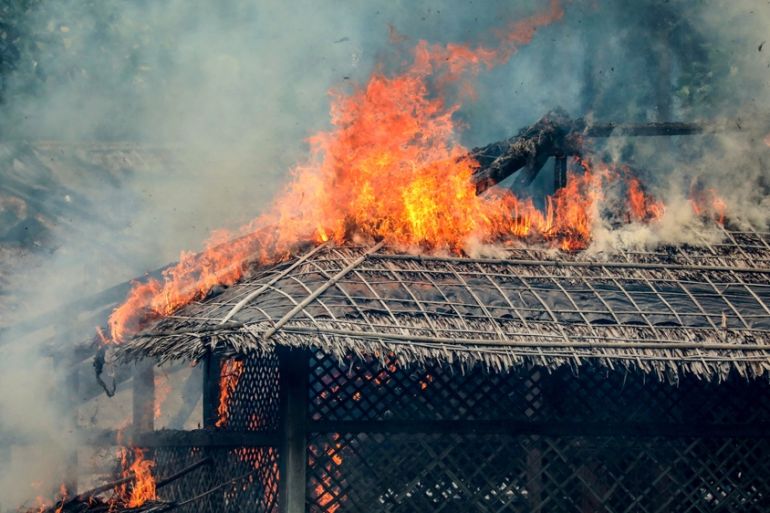Myanmar uses scorched earth tactics in Rakhine: report
Amnesty accuses Myanmar army of carrying out ‘ethnic cleansing’ of the Rohingya, as nearly 400,000 flee to Bangladesh.

Security forces and vigilante mobs in Myanmar are carrying out a scorched-earth policy in the majority-Muslim region of Rakhine State, burning down entire Rohingya villages and shooting at people as they try to flee, Amnesty International has said.
Keep reading
list of 4 itemsConflict, climate, corruption drive Southeast Asia people trafficking: UN
Bodies of three Rohingya found as Indonesia ends rescue for capsized boat
How is renewed violence in Myanmar affecting the Rohingya?
According to new satellite imagery, fire-detection data, photographs and videos from the ground, the human rights group said on Thursday that there were at least 80 large-scale fires in inhabited areas across northern Rakhine State since 25 August.
“The evidence is irrefutable – the Myanmar security forces are setting northern Rakhine State ablaze in a targeted campaign to push the Rohingya people out of Myanmar,” said Tirana Hassan, Amnesty International’s Crisis Response Director.
“Make no mistake: this is ethnic cleansing.”
At least 370,000 Rohingya are estimated to have fled from Rakhine State to neighbouring Bangladesh after fighters from the Arakan Rohingya Solidarity Army (ARSA) attacked police posts, sparking a major military backlash.
Myanmar’s government said on Wednesday that nearly 40 percent of Rohingya villages had been targeted by the army in so-called “clearance operations,” with 176 out of 471 villages empty of people, and an additional 34 villages “partially abandoned.”
READ MORE: Who are the Rohingya?
According to the report, Rohingya said that soldiers, police and vigilante groups would sometimes encircle a village and fire into the air before entering, but would often just storm in and start firing in all directions.
|
|
“When the military came, they started shooting at people who got very scared and started running. I saw the military shoot many people and kill two young boys. They used weapons to burn our houses,” one survivor said.
“There used to be 900 houses in our village; now only 80 are left. There is no one left to even bury the bodies.”
Amnesty said it was able to corroborate the burning by analysing photographs taken from across the Naf River in Bangladesh, showing huge pillars of smoke rising inside Myanmar.
The international rights organisation said that in some areas, local authorities warned villages in advance that their homes would be burned, a clear indication that the attacks were both deliberate and planned.
WATCH: The Hidden Genocide – A special Al Jazeera investigation
One witness from Pan Kyiang village in Rathedaung township described how in the early morning of September 4, the military came with the village administrator: “He said by 10am today we had better leave since everything would be set on fire.”
As his family was packing up their belongings, he saw what he described as a ‘ball of fire’ hitting his house, at which point they fled in panic.
Villagers who hid in a nearby paddy field witnessed soldiers burning houses using what appears to be rocket launchers.
Amnesty said the exact number of fires and extent of property destruction could be much higher, as cloud cover during the monsoon season has made it difficult for satellites to pick up all burnings.
Security has deteriorated sharply in Rakhine since Aung San Suu Kyi’s government sent thousands of troops into Rohingya villages and hamlets last October after nine policemen were killed by ARSA.
The security forces’ offensive has been beset by allegations of arson, killings and rape; with Antonio Guterres, the UN secretary-general, warning of the risk of ethnic cleansing.
Aung San Suu Kyi has been widely condemned for lack of moral leadership and compassion in the face of the crisis, denting the Nobel Peace Prize laureate’s reputation.
|
|